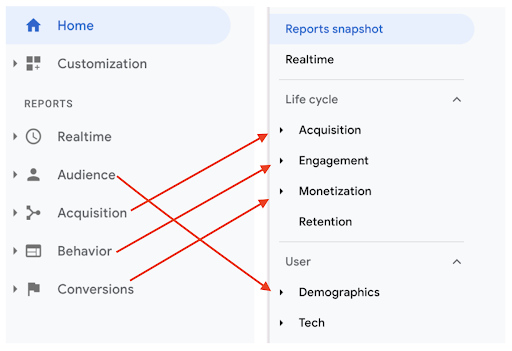(Updated October 2022)
There’s been much attention to industry changes in data privacy and the phasing out of third-party cookies by the likes of Apple and Google. But another development has flown under the radar and will also force an immediate evolution for marketers in how they measure performance and decipher user behavior. This spring, Google added a new wrinkle when it announced that Google Analytics Universal Analytics (UA) will sunset on June 30, 2023 (enterprise clients who subscribe to Analytics 360 have until July 2024). By that date, customers of the ubiquitous measurement platform must transition to Google Analytics 4 (GA4).
As mobile devices continue to outpace desktop, and privacy becomes a more important factor in the user experience, GA4 is theoretically designed to help marketers gain fuller insight into current behaviors while also preparing for the cookie-less world coming in 2024. However, it is important to stress that GA4 is not just a minor technical update to the Google Analytics with which we’ve become familiar.
Compared to UA, GA4 approaches measurement and tracking in a fundamentally different way. In UA currently, each hit is fragmented into categories, such as ‘Page Views’ and ‘Events’, all of which occur during a ‘Session’, user interactions measured within a timeframe. In GA4, pageviews and sessions are no longer the key components of site metrics, so measurement strategies that have focused on these KPIs will need to be reconsidered wholesale.
Instead, GA4 introduces a new, event-based tracking model which is designed to provide a holistic picture of a user’s journey across platforms and devices. Each event can be configured with parameters which provide richer information about the ways users interact with your website. For example, if a user interacts with content that they find interesting, you can include a descriptive parameter to bolster your analysis, whether it’s “blog”, “infographic”, or “image”. Another parameter can then be added to track what social platform your user subsequently shared that piece of content. In GA4, Google provides a default set of required and optional parameters to include with each recommended event, in addition to the ability to define your own. Finally, all interaction data is combined from Website, iOs Apps, and Android Apps, providing visibility into the different touch points that led to conversion.

The nomenclature of the tracked data is also changing. Instead of ‘Behavior’, ‘Audience’ and ‘Conversion’, in GA4 you will see ‘Acquisition’, ‘Engagement’, ‘Monetization’ and ‘Retention’. As a result, the migration requires a reset of reporting strategies and dashboards because there is not a one-to-one mapping of the data collected in UA to GA4. In addition, GA4’s attribution models and predictive analytics can power the way you look at budgets and change how you optimize the full customer journey – all of which will require upfront study and measurement planning to take advantage of fully.

Above: The nomenclature of the tracked data is also changing. Instead of ‘Behavior’, ‘Audience’ and ‘Conversion’ (left), in GA4 you will see ‘Engagement’, Demographics, and ‘Monetization’ (right).
GA4 is also built to anticipate the sea change in data collection models that will happen when third party cookies are banished from browsers. GA4 will depend solely on first party data – the data that is collected and used only on the website the user is visiting. This shift provides marketers with a tool with robust privacy controls but also more control of their data. Again, this is an opportunity that will require planning to put into operation.
There’s an old adage that you “manage what you measure”, so when you change how you’re measuring something, it’s going to change how you manage it too. So what are the immediate implications of this change to those that use Google Analytics to track site performance?
- After July 2023, UA will stop processing data, and only GA4 will be available for use. An important first step – which should be put in motion right away if it has not been done yet – is to install GA4 so that you begin to collect data in the new format in parallel to the UA data. You will need a runway of historical GA4 data to compare the differences in user interface and reporting and align stakeholders on new reporting KPIs.
- Make a plan to retrain your team. There are many differences between UA’s hit-based tracking vs GA4s event-based tracking, as well as overall changes in the structure of the reporting sections.
- Year-over-year comparisons will take more work. Data in GA4 will not be available retroactively, so if you are just installing GA4 now, prepare for a gap in data for YoY comparisons come July 2023.
- For standard Universal Analytics properties, historical data will only be stored for an additional 6 months after July 2023, so storing any useful tracked data offline will be mandatory for any historic analysis or comparisons.
- Make a plan to update media integrations to account for new goals and audiences.
While the saying that “marketers are only as good as their data” may be overstated, we cannot underestimate the positive impact that focused, clear analytics can have on strategy, communications, budgeting, and driving revenue. By planning the transition to GA4 now, you will be better positioned to understand the critical events and key digital trends impacting your organization now and in the future.
If you haven’t yet started the process of setting up GA4 and would benefit from some guidance, reach out.